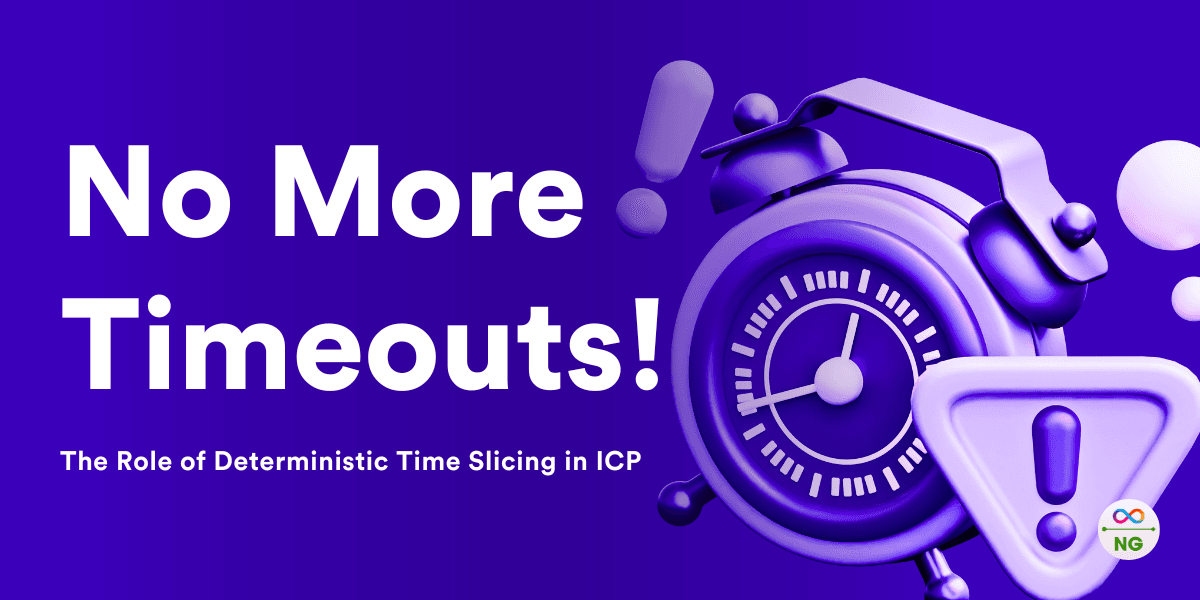
Deterministic Time Slicing (DTS) is a key innovation powering this transformational mechanism that allows developers to execute complex, long-running computations without hitting execution limits. I call it the “Big Tasks, Small Pieces magic.” This article breaks down how DTS works, its impact on canister execution, and why it is a game-changer for developers building decentralized applications (dApps) on the IC.
The Challenge of Execution Limits in Blockchains
Most blockchains have strict execution limits per block. For developers building advanced applications, these limits create significant roadblocks. Tasks like image processing, large-scale data analysis, or machine learning models often require more computational power than a single block can handle.
Once execution limits are exceeded, transactions time out, leading to failed operations and poor user experience. This restriction has made it difficult to deploy certain categories of applications on traditional blockchains.
How Deterministic Time Slicing Solves the Problem
The Internet Computer introduces Deterministic Time Slicing (DTS) as a solution. DTS ensures that long-running computations are automatically split into smaller, manageable slices. These slices execute sequentially across multiple blocks, preventing execution failures while maintaining system efficiency.
How Deterministic Time Slicing Works
DTS is integrated at the system level within the Internet Computer’s execution environment. Whenever a canister runs a computation that surpasses execution limits, the system automatically breaks it into smaller slices. Each slice is executed in a separate block, ensuring a smooth flow of operations without overloading any single block.
Key Features of DTS
Deterministic Execution
Every computation slice produces the same predictable results, regardless of when it runs. This consistency is crucial for ensuring the blockchain remains secure and free from unexpected behaviour. Unlike traditional systems where external factors might influence execution outcomes, DTS guarantees uniformity, reinforcing trust in decentralized applications.
Automatic Process
Developers can focus entirely on building their applications without worrying about execution limits. The IC’s runtime environment takes care of slicing computations into smaller tasks without requiring additional configuration or special commands. This seamless automation makes it easier to develop high-performance dApps without dealing with complex execution constraints.
State Management
The IC ensures that computation slices maintain continuity, preventing data loss and inconsistencies. Every slice begins where the previous one left off, preserving context across multiple execution blocks. This feature is particularly useful for long-running operations that require intermediate states to be stored and processed without interruption.
Impact of DTS on Canister Execution and Performance
DTS significantly improves canister execution in multiple ways:
- No More Timeouts: Large computations no longer get stuck or fail due to execution limits.
- Better Responsiveness: Applications remain responsive even when handling complex tasks, ensuring a smoother user experience.
- Scalability Boost: The IC can process more complex computations efficiently, making it suitable for a broader range of applications.
How Developers Can Optimise Canisters for DTS
While DTS operates automatically, developers can take certain steps to maximise efficiency:
- Optimise Code: Writing clean, modular, and efficient code helps DTS break down tasks more effectively. Well-structured code allows for better partitioning and minimises unnecessary computational overhead.
- Choose the Right Algorithms: The choice of algorithms directly impacts performance. Selecting algorithms with lower computational complexity ensures faster execution and reduces resource consumption. Developers should prioritise those that optimise processing time while maintaining accuracy.
- Leverage Asynchronous Operations: Implementing non-blocking operations prevents canisters from becoming unresponsive. By allowing computations to run independently, applications remain smooth and interactive, even when handling heavy tasks.
- Manage State Efficiently: Understanding how the IC manages state between slices can further improve performance. Proper state management minimises redundancy, reduces execution time, and ensures seamless progress between slices, optimising application efficiency.
The Future of Decentralized Computing with DTS
AI and Machine Learning
The ability to run AI models on-chain unlocks new opportunities for decentralized intelligence. Developers can now create AI-driven applications that operate securely on the blockchain, eliminating the need for external computation services. This paves the way for decentralized AI marketplaces, autonomous smart contracts powered by machine learning, and AI-driven analytics that operate directly within a decentralized environment.
Big Data Processing
Applications requiring large-scale data analysis can now operate efficiently on the IC. DTS ensures that heavy computations, such as processing financial data, analysing user behaviour, or running scientific research simulations, are seamlessly handled without overloading the system. Businesses leveraging blockchain for real-time analytics, fraud detection, or predictive modelling can now do so without performance bottlenecks.
Advanced Simulations
DTS allows developers to create complex simulations that were previously impossible on blockchain networks. From simulating financial markets and economic trends to running physics-based models and gaming environments, the IC can now support high-fidelity simulations with continuous execution across multiple blocks. This advancement makes the IC a viable platform for sectors such as DeFi, scientific research, and virtual reality applications that require real-time, computationally intensive modelling.
Conclusion
Deterministic Time Slicing is a groundbreaking feature that distinguishes the Internet Computer from other blockchain platforms. With DTS, developers can execute complex computations seamlessly, eliminating the limitations that have long hindered blockchain applications.
As the Internet Computer continues to evolve, DTS will remain at the core of its mission to redefine decentralized computing. This innovation empowers developers, enabling them to build applications that are more powerful, scalable, and impactful than ever before.
Article By: Mana Lamja